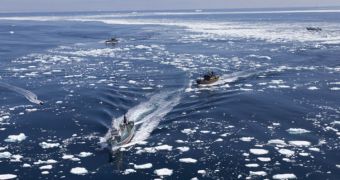For the first time this whaling season, the Sea Shepherd Conservation Society (SSCS) and the Japanese whaling fleet have crossed paths in the frozen, ice-laden waters of the Antarctic. Three Sea Shepherd vessels went up against three Japanese harpoon ships and one factory ship.
Japan is currently conducting illegal whaling under a legal loophole in a 1984 UN moratorium that prohibits commercial whaling. The Asian nation claims that all the 1,000+ whales it wants to catch every single year are for research.
However, that is a lie. Most of that meat reaches Japanese supermarkets, where they are sold for profit – the very definition of commercial use. Sea Shepherd, Greenpeace and other environmental groups have shown on numerous occasions the corruption of the Japanese system.
While Greenpeace prefers to adopt other types of tactics, the SSCS is in favor of a more direct approach, in which they try to stop the whaling fleet from reaching its seasonal quota.
This is achieved by interfering with everyday operations aboard the Japanese ships. This is why SSCS ships follow the Japanese vessels through the Antarctica every single year.
“Our three vessels dancing dangerously through the ice packs locked in confrontation with the three harpoon ships of the Japanese whaling fleet. It was both deadly and beautiful,” says Locky MacLean of Canada, the pilot of the SSCS ship Gojira.
“Deadly because of the ice and the hostility of the whalers and beautiful because of the ice, and the fact that these three killer ships are not killing whales while clashing with us. What an awesome way to begin the New Year,” he adds.
As always, the main target of the SSCS fleet is the Japanese Nisshin Maru factory ship. The three whalers, Yushin Maru, Yushin Maru #2, and the Yushin Maru #3, attempted to block the organization's ships from engaging in a pursuit, but failed.
The Gojira was accompanied by the Steve Irwin and Bob Barker the other two vessels that SSCS operates in the area. The group also has a helicopter, which it uses to track down its targets.
“We’ve got them before they were able to kill a single whale. They are not whaling today and our challenge now is to make sure they don’t kill any whales in the coming days,” explains SSCS campaign leader, Captain Paul Watson.
“Our objective is to save the maximum number of whales and to maximize the financial losses of the whalers at the same time,” Watson adds in a statement.
Due to the fact that it has three ships available, the SSCS will this year be capable of always chasing the Japanese fleet, rather than having to return to Australia or New Zealand for refueling.
Australia last year sued Japan at the International Court of Justice for violating the UN agreement, and failing to respect its provisions.

 14 DAY TRIAL //
14 DAY TRIAL //